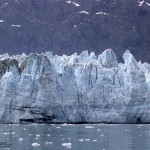A wall of ice, hundreds of feet high, towering above the water with jagged teeth waiting to crush any hapless vessel below under blocks of ice the size of minivans. The stuff of adventure novels and endless nature documentaries. Such places do exist, where the power of nature is seen raw and in full glory. Witnessing such a spectacle is worth making the effort to get to one of these remote places, where rivers of ice meet the sea.

The show is generally best on a rising tide, as the sea level increases the face of the glacier is lifted and the most unstable pillars of ice come crashing down. Watching from a safe distance gives a chance to see the process in action. No guarantee of a large collapse, no way to predict what will fall on any given day. One can only try to time their visit with high tide to allow the best chance of seeing ice collapses.
When one of the towering seracs does collapse it generally gives warning, small ice falls around it increase in frequency. Something that large does not move fast, but collapses with a slow motion slide into the water. A photographer with a ready camera will have ample opportunity to grab a few frames as the avalanche of ice comes down. The collapse will create a large wave that threatens any nearby vessels, wise to stay well back. Even half a mile away the waves created by the ice will rock any vessels in the fjord.
